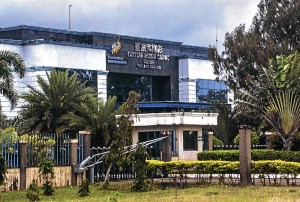
THE CASINO complex of the Eastern Hawaii Leisure Co. Ltd. inside the Cagayan Special Economic Zone and Freeport in Sta. Ana (see map) draws foreign high rollers. RICHARD BALONGLONG
For people unfamiliar with it, any mention of the Cagayan Special Economic Zone and Freeport (CSEZFP) immediately brings to mind a visual comparison with the more familiar Subic Bay Freeport in Zambales.
But first-time visitors who expect to see a developed Subic-like environment in Sta. Ana, Cagayan, usually end up disappointed, as there is little or no comparison. They would have to travel deep into town to see a casino complex, a row of villas that provide five-star accommodation to mostly foreign gamblers, an airstrip and another casino-cum-leisure resort.
Others, however, might welcome the still rural setting: less crowds, several clean beaches, fresh air and verdant rice fields that complement the mountains in the background.
Used-car industry
But this free port is known less for its tourism potential and more for the recent controversy over its used-car industry, following a Supreme Court ruling that upheld the ban on the importation of used cars and vans for resale in the country.
Port officials have expressed concern over the looming economic losses faced by the local community and the government once the ban becomes permanent.
The CSEZFP was created on Feb. 24, 1995, through Republic Act No. 7922, also known as the Cagayan Special Economic Zone Act of 1995 which was authored by Senate President Juan Ponce Enrile, a native of neighboring Gonzaga town. It is located at the northeastern tip of the Luzon mainland, about 620 kilometers north of Manila.
The port occupies 41,000 hectares of land, an area almost three times the size of Quezon City.
In its entirety, the CSEZFP covers approximately 54,000 ha of “urban, suburban and agro-industrial lands for prime development,” according to the website of the Cagayan Economic Zone Authority (Ceza), the agency tasked with managing and supervising the port’s operations.
There has been sporadic development in the town, mainly spurred by enterprising locals and foreign investors, known as “locators.” Its officials said Ceza’s main thrust is to develop the CSEZFP as an interactive gaming, shipping and ecotourism hub in Southeast Asia.
But the used-car trade is hard to ignore.
From the port’s main entrance in Casambalangan village, visitors are greeted by rows and clusters of imported used cars, vans, buses and trucks that make the town seem like a sprawling parking lot, with makeshift hangars and single-story buildings scattered within the 5-ha yard.
The concrete road swoops downhill and splits: to the left is the main gate to Port Irene, CSEZFP’s main port, and to the right, a road to the town proper that traverses five villages until it hits a dead end at the fish port in San Vicente village, 20 km from the entrance.
The 1.5-km access road leading to Port Irene, currently undergoing repair, is a paved two-lane boulevard, now being “abused”—as the locals described it—by scores of dump trucks transporting processed magnetite for export to China from black sand mining sites in the six northern towns of Cagayan.
Two newly painted warehouses stand out as the main structures at the port. A two-story building sits behind, supposedly occupied by Forerunner Multi-Resources Inc., the main
In another compound, mounds of towering black sand waited to be loaded on a 7,000-ton cargo ship docked at the main pier. Equipment used for loading the sand stood idle while laborers loitered around, a stark contrast to the day before when two ships loaded with magnetite left Port Irene.
Almost adjacent to the car lot in Casambalangan is the main residential area, with two single-pump gasoline stations, a covered barangay gymnasium and a public high school serving as local landmarks.
‘Jai alai’ fronton
The next 10 km of the main road that traverses Rapuli and Diora-Zinungan villages open up to a mostly underdeveloped rural landscape that offers a scenic view of the bay dotted with a number of beach resorts. Further along is the imposing jai-alai fronton of the Ceza-licensed Meridien Vista Gaming Corp.
Development has started to shape the road’s 3-km stretch from Barangay Diora-Zinungan to Barangay Centro, where the casino complex of Eastern Hawaii Leisure Co. Ltd. and a row of villas offering five-star accommodation to foreign players dominated the landscape. The town center has a rural bank, two gasoline stations, several construction supply stores, as well as a few mini-grocery outlets and restaurants.
At the far end of this business district is the Sta. Ana public market, which bristles with activity on Thursdays and Sundays, the designated market days.
The scenery reverts to its countryside charm in Palawig and Santa Cruz villages despite random business structures.
Once in the village of Tangatan, however, visitors are greeted by the imposing structures of Sun City Cagayan Holiday and Leisure Resort, another casino-cum-resort that caters mainly to foreign gamblers.
The whole complex extends to the village of San Vicente and shares the airstrip of the Philippine Navy’s Camilo Osias Operating Base.
The end of the national road leads to the San Vicente fish port, which also serves as a docking facility for passenger ferries bound for the eastern coastal towns of Isabela, as well as for boats that bring tourists to nearby Palaui Island, one of the town’s main tourist attractions.